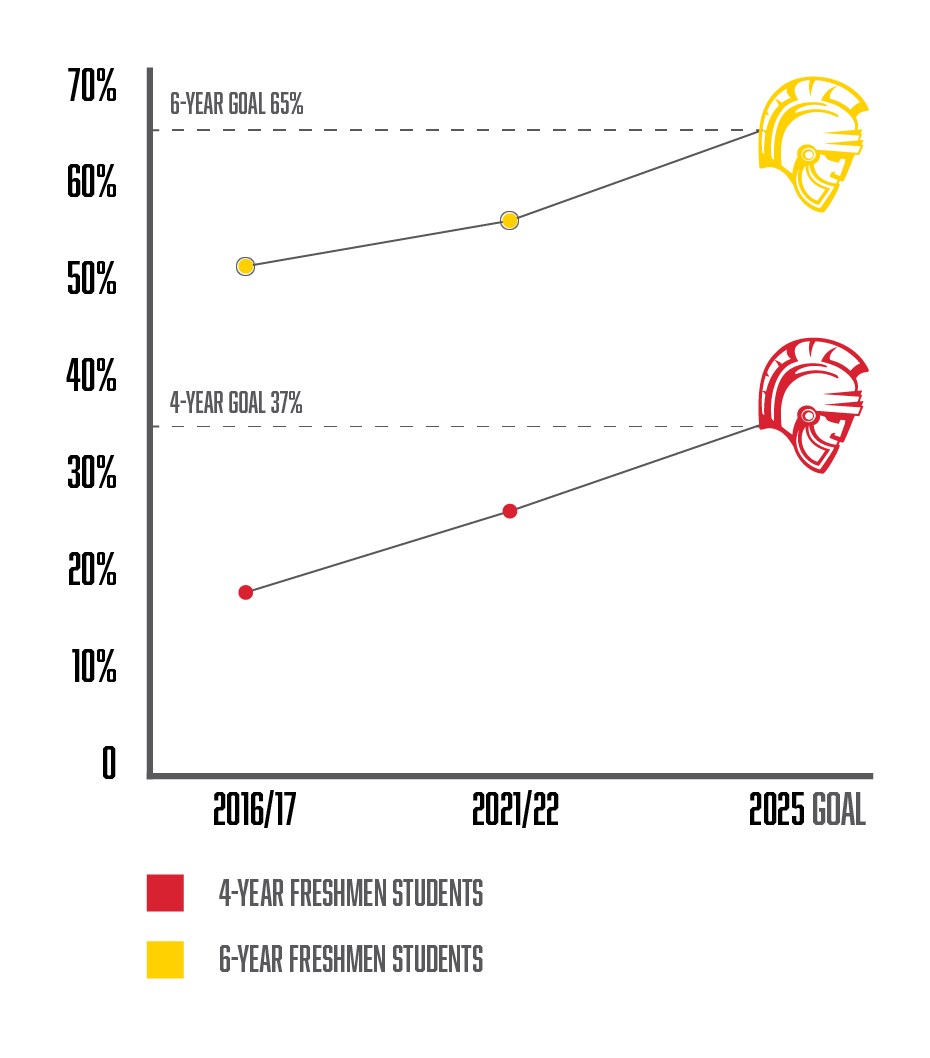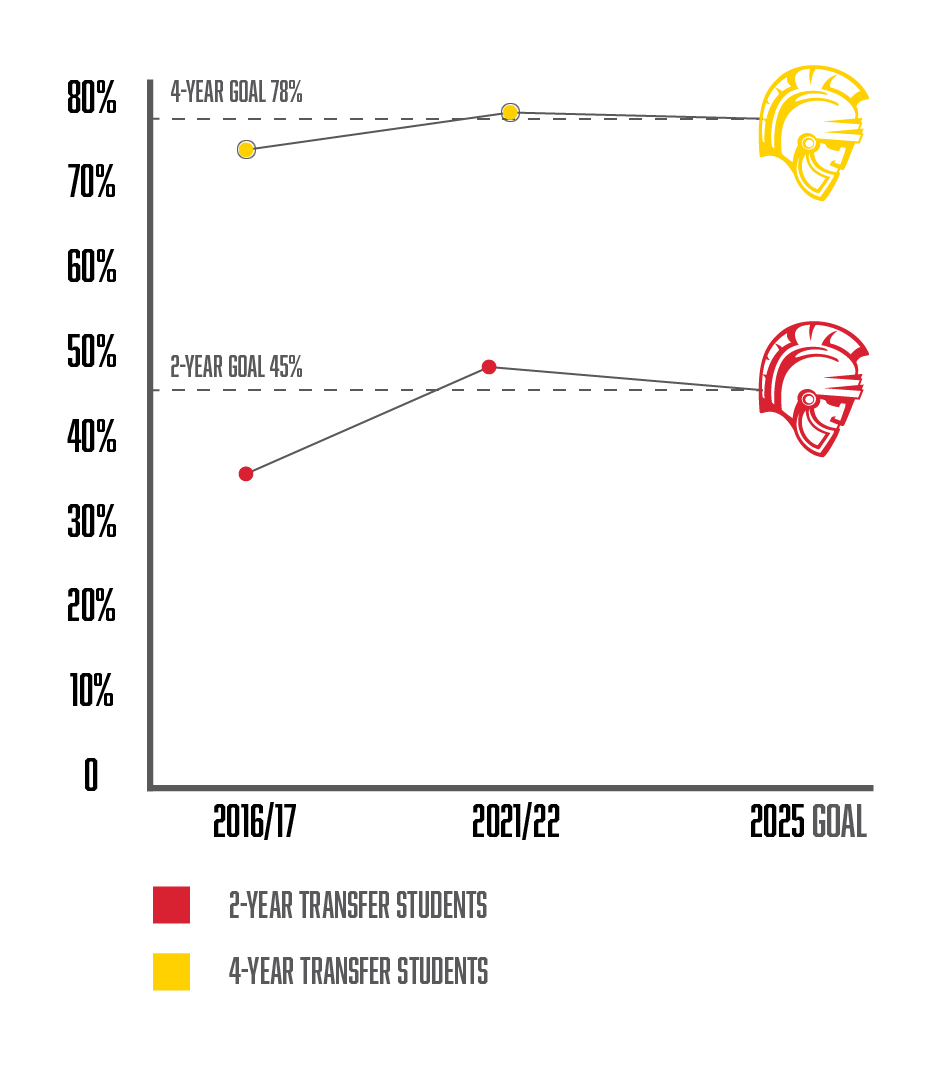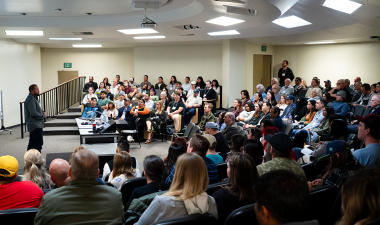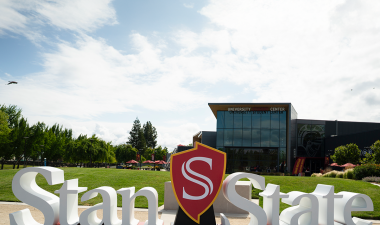The culmination of the California State University’s Graduation Initiative 2025, the 10-year plan to increase graduation rates and narrow the completion gap between underrepresented students and their peers across the CSU campuses, is nearing.
The Class of 2025, which began in fall 2021, represents the final benchmark of the effectiveness of programs and processes enacted since former Chancellor Timothy White unveiled the initiative in 2015 with a goal, among others, of graduating 65 percent of first-year students within six years.
Members of Stanislaus State’s Class of 2025 know they’ll be remembered for more than their graduation rate.
They will always be known as the COVID Class, the students who began college in the wake of a life-altering worldwide pandemic.
They completed high school online; some without the chance to walk across a commencement stage. They applied to Stan State and were accepted virtually and navigated financial aid online. For them, New Student Orientation was virtual.
When classes finally began in fall 2021, they attended them online, the Delta strain of COVID-19 forcing in-person instruction to be delayed until October.
Previous incoming students faced challenges, first-year biology major Angeles Ramirez concedes, but the Class of 2025?
“I think our class was motivated to continue and graduate because we made it. We’re here!” Ramirez said.
Their optimism and determination permeate the picturesque campus whose graduation numbers have risen.
The four-year graduation rate of Stan State’s first-year students who began in 2015 when the initiative launched, was 18.9 percent. That rate jumped to 25.6 in two years.
Stanislaus State Graduation Rates

6-year freshmen graduation rates were 52.8% in 2016/17, 57.6% in 2021/22. The 2025 goal is 65%.

4-year transfer graduation rates were 76.9% in 2016/17, 78.4% in 2021/22. The 2025 goal is 78%.
The University’s efforts toward that improvement include:
- Warrior Connect, the online student success platform that made it easier for students to book appointments and communicate with advisors while providing advisors with more efficient access to student data enabling them to engage in targeted interventions and communications to better serve students;
- Enrollment services pre-enrolling incoming students in math and English, based on their majors, to help them successfully complete those general education requirements;
- Creation of a Stretch English program, which allows students who may struggle with English to complete the requisite class over two semesters instead of one;
- The offering of early-start math and English courses for incoming first-year students whose academic records indicate they may struggle with those required classes;
- Waiving the enrollment confirmation deposit for students in need;
- Extending the credit/no credit deadline;
- Streamlining the graduation approval process;
- Increasing the fee threshold for drop for non-payment to $1,000;
- Extending the deadline for payment of student fees;
- Continued expansion of Educational Opportunity Program (EOP) services which offer professional and peer counseling;
- Creation of the Freshman Success Program, built on the EOP model but open to first-year students not in another assistance program;
- Work on a digital planner in a convenient mobile app that will replace the current Stan Degree Planner;
- Expansion of retention campaigns to ensure no students leaves Stan State without being offered additional support.
As the 2025 deadline approached, the pandemic was a motivating factor in creating even more services.
“COVID propelled us to take action on some things we knew we needed to work on,” said Gabriela Nuño, director of the Academic Success Center, who oversees academic advisors and EOP.
Specifically, the launch of Warrior Connect, accessible through every student’s myStanState account, went live in 2020, ahead of schedule. It links each student with an academic advisor, their first point of contact, to offer academic assistance and information on resources.
Peer counselors were available to all first-year students, including through the Freshman Success Program, launched by Academic Advisor Eilbret Younan in 2019.
“I can relate to them,” Younan said. I wasn’t a first-gen college student, but I was a transfer student from Modesto Junior College.”
The majority of Stan State students — 74 percent — are the first in their families to pursue a college degree, though, and applying, registering, obtaining financial aid and finding guidance are all challenges.
One hurdle that was removed for the Class of 2025 was the need to take the Scholastic Aptitude Test (SAT) or American College Test (ACT).
“Some might have assumed the academic profile of students would have been less because of this, but it wasn’t,” said Interim Director of Admissions and Outreach Miguel Pulido. “What I saw and peers from other campuses saw, was students who had a strong GPA but weren’t good test takers and otherwise wouldn’t have applied, suddenly saw an opportunity. We received applications from very qualified students.”
The class of first-year students of just more than 950 is smaller than Pulido anticipated, but he’s inspired by what he sees in the Class of 2025.
He has a student working in his office leading campus tours who, like Ramirez, epitomizes the spirit of the Class of 2025.
“He has a sense of urgency to make up for lost time,” Pulido said. “He said, ‘I’ve been gone for so long, the pandemic took so much away, I want to get an on-campus job; I want to join a club; I want to make the most of my experience.’ I don’t know if being quarantined helped him figure out his short-term and long-term goals, but he told me he’s going to get a Ph.D. in physical therapy. He’s a freshman. When I was a freshman, I was only thinking about what I was going to take the next semester. I’m so inspired by these students, making the best out of a difficult situation and doing so without feeling broken.”
Whether they know it or not, the first-year students of the Class of 2025 are reaping the benefits of GI 2025.
“I’ve been on campus for 15 years. I’ve seen the evolution,” Nuño said. “So many people across campus took it upon themselves to look at their own impact on students. Whether teaching in a classroom or working with a program, they really reflected and made changes to improve their own departments. I think that’s the beauty of it.
“In meetings, GI 2025 was referenced, but the thought was we should do this because we want to improve.”



